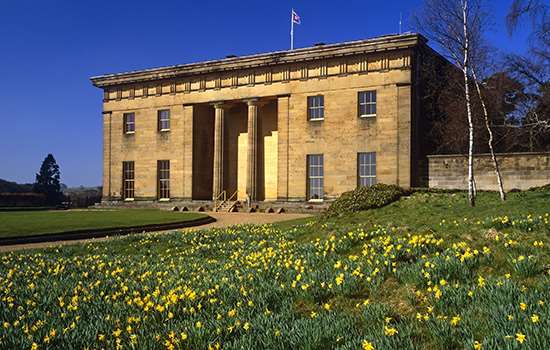Pushing boundaries: McQueen to McCartney
Contemporary art is an exciting way to explore a historic space. It can connect stories and places with the present, encouraging us to see the space afresh and from different perspectives. Belsay is a particularly rich space for artistic interpretation: the empty, unfurnished rooms of the Hall and Castle invite imagination and wonder.
Over the past couple of decades Belsay has pioneered a programme of bold artistic commissions. Among its most famous displays was ‘Fashion at Belsay (FAB)’ in 2004. Internationally renowned fashion designers including Stella McCartney, Alexander McQueen and Paul Smith were asked to respond to the site with art installations rather than their usual catwalk creations. McCartney’s artwork took the form of an enormous prancing horse made of crystals that was suspended from the roof of Belsay Castle’s Great Hall.
‘Picture House’ in 2007 installed works by 15 artists across the hall, castle and gardens and included three full-sized trees in a bedroom and over 1,000 teacups. In 2010, ‘Extraordinary Measures’ played on the theme of scale while 2016’s ‘Outside In’ was inspired by the landscape, and featured photographs and sculptures by artists such as Andy Goldsworthy and Halima Cassell.
Susan Philipsz and ‘The Yellow Wallpaper’
In 2018 the Turner Prize-winning artist Susan Philipsz filled Belsay Hall with her haunting sound installation, ‘The Yellow Wallpaper’. Inspired by the intimate yet abandoned spaces of the upstairs bedrooms, Philipsz installed speakers in the chimney flues to project overlapping loops of songs throughout the building. The disembodied voices drew on the themes of the famous short stories ‘The Yellow Wallpaper’ by Charlotte Perkins Gilman and ‘The Murders in the Rue Morgue’ by Edgar Allen Poe. Both stories deal with the haunting of domestic spaces, and Philipsz’s work likewise encouraged visitors to imagine the personal stories of loss and desire at Belsay that may never be told.
The songs themselves were based on local border ballads. Belsay is situated in an area once known as the ‘debatable land’, the disputed territories between England and Scotland where violence and lawlessness abounded. Tales of love, hate and longing survive through the ballads, and they are part of the living heritage of the Borders. In her sound installation, Philipsz sung versions of ‘The Unquiet Grave’ and ‘Oh Willow Waly’.
Local perspectives
As part of the Susan Philipsz installation, young artists from Ashington College near Newcastle were invited to create their own sound artwork that explored their relationship to the local heritage environment. During ten collaborative workshops tutors Tess Denman-Cleaver and Tim Shaw worked with students Rebecca Flynn, Emily Pattison and Robin Webley to build bespoke microphones, develop technical and artistic approaches to field recording, and generate site-responsive text and images.
English Heritage documented their progress, from their early visit to Belsay Hall through to the display of their final artwork, ‘Rather Than to See’, in central Newcastle. Listen to the documentary using the SoundCloud player on this page, or download a full transcript of the audio.
The project was commissioned by English Heritage and supported by Arts & Heritage and Arts Council England.
Top image: Detail from the interior of Belsay Hall




